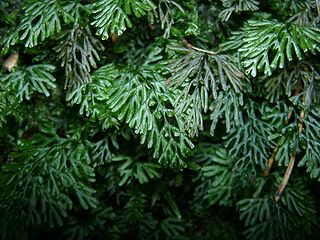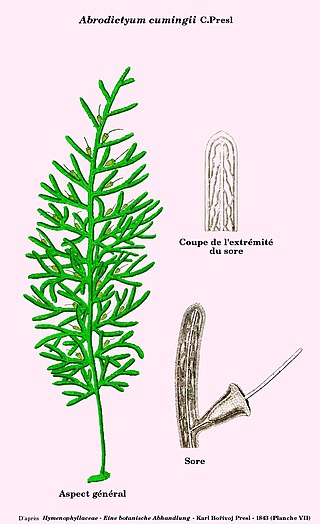
R is a programming language for statistical computing and graphics supported by the R Core Team and the R Foundation for Statistical Computing. Created by statisticians Ross Ihaka and Robert Gentleman, R is used among data miners, bioinformaticians and statisticians for data analysis and developing statistical software. The core R language is augmented by a large number of extension packages containing reusable code and documentation.

The Hymenophyllaceae, the filmy ferns and bristle ferns, are a family of two to nine genera and about 650 known species of ferns, with a subcosmopolitan distribution, but generally restricted to very damp places or to locations where they are wetted by spray from waterfalls or springs. A recent fossil find shows that ferns of Hymenophyllaceae have existed since at least the Upper Triassic.

Hymenophyllum is a genus of ferns in the family Hymenophyllaceae. Its name means "membranous leaf", referring to the very thin translucent tissue of the fronds, which gives rise to the common name filmy fern for this and other thin-leaved ferns. The leaves are generally only one cell thick and lack stomata, making them vulnerable to desiccation. Consequently, they are found only in very humid areas, such as in moist forests and among sheltered rocks. They are small and easy to overlook.
Hypnodontopsis is a genus of haplolepideous mosses (Dicranidae) in family Rhachitheciaceae.

Thamnobryum is a genus of moss in the family Neckeraceae. There are about 50 species. The genus is distributed throughout the world.

Hypnaceae is a large family of moss with broad worldwide occurrence in the class Bryopsida, subclass Bryidae and order Hypnales. Genera include Hypnum, Phyllodon, and Taxiphyllum.

The Hookeriaceae are a family of mainly tropical mosses of the order Hookeriales.

Calypogeiaceae is a family of liverworts. This type of plant is a calcifuge.
Daltoniaceae is a family of moss in the order Hookeriales.

Taxiphyllum is a genus of mosses in the family Hypnaceae.

Abrodictyum is a fern genus in the family Hymenophyllaceae. The genus is accepted in the Pteridophyte Phylogeny Group classification of 2016 but not by some other sources, which sink it into a broadly defined Trichomanes.

Cephalomanes atrovirens is a species of fern in the family Hymenophyllaceae. The genus Cephalomanes is accepted in the Pteridophyte Phylogeny Group classification of 2016, but not by some other sources. As of October 2019, Plants of the World Online sank the genus into a broadly defined Trichomanes, while treating the subtaxa of this species as the separate species Trichomanes acrosorum, Trichomanes atrovirens, Trichomanes boryanum and Trichomanes kingii.

Polytrichastrum formosum, commonly known as the bank haircap moss, is a species of moss belonging to the family Polytrichaceae.

Pseudotaxiphyllum is a genus of mosses belonging to the family Plagiotheciaceae.
Herzogiella is a genus of mosses belonging to the family Hypnaceae.
Isopterygiopsis is a genus of mosses belonging to the family Plagiotheciaceae.

Phaeoceros carolinianus is a cosmopolitan species of hornwort. Often seen near streams or moist situations.
Podperaea baii is a species of moss from the genus Podperaea. It was discovered by Mikhail Stanislavovich Ignatov in 2011. In 2020, Podperaea baii had a synonym named Redfearnia baii.
Podperaea krylovii is a species of moss in the genus Podperaea. Found in Asia, it was transferred to the genus Podperaea by Zennosuke Iwatsuki and Janice Mildred Glime.

Plagiotheciaceae is a family of mosses from the order Hypnales. It is found almost nearly worldwide, including Antarctica. Located primarily in temperate latitudes and at higher elevations in the tropics.













